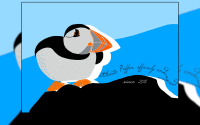Common Dreams / Published on Saturday, December 16, 2006 by ReutersDeborah Zabarenko
The first Adelie penguin chicks of the season -- black fluffballs small enough to hold in the hand -- started hatching this month, and the simple fact that there are more of them in the south and fewer of them further north is a sign of global warming, scientists say.
 Adelie penguins make there way to the water in the Cape Evans region of Antarctica in this file picture. The first Adelie penguin chicks of the season -- black fluffballs small enough to hold in the hand -- started hatching this month, and the simple fact that there are more of them in the south and fewer of them further north is a sign of global warming, scientists say. REUTERS/Mark Baker Adelie penguins make there way to the water in the Cape Evans region of Antarctica in this file picture. The first Adelie penguin chicks of the season -- black fluffballs small enough to hold in the hand -- started hatching this month, and the simple fact that there are more of them in the south and fewer of them further north is a sign of global warming, scientists say. REUTERS/Mark Baker |
"We're looking for dramatic right-hand turns (in the penguin population), which are happening now," Ainley said. "The rate of Adelie penguin colony disappearance is accelerating as the sea ice disappears."
As the northern sea ice vanishes and penguin populations decrease, southern penguin colonies flourish as the sea ice loosens, making it easier for them to dive and fish, he said.
Adelies and Emperors are the two species of penguin that live on sea ice; all other penguins dwell in open water.
"Adelies and Emperors have the ability to cope with sea ice," Ainley said. "They have an incredible ability to lay on layers of fat when the sea ice is heavy."
For example, he said, Adelies can hold their breath for six minutes at a time and Emperors can go without a breath for 20 minutes at a time, allowing both species to forage for food underneath the ice.
They eat fish, squid and tiny creatures called krill.
Adelie penguins have moved around depending on the temperature at least since the so-called Little Ice Age that occurred around the year 1200, Ainley said.
"As the Earth cooled slightly, Adelie colonies began to appear further north during the Little Ice Age," he said. "But since then, Adelies have been retreating, and in the past 30 years this process has been accelerating."
When asked whether there is any doubt that this is a consequence of human-fuelled global warming, Ainley offered a flat "No" in reply.
ROCK THIEVES
To keep track of the Adelie colonies at three sites in the vicinity of McMurdo Station, Ainley and his team band hundreds of the new chicks and insert bar code identifying chips under the skin near the shoulders of the adults.
"You'd never be able to collect any meaningful data without these techniques," he explained, noting that you might be able to weigh a certain penguin once, but it would be virtually impossible to identify that penguin again for a repeat weighing.
As it is, scientists have constructed a weigh bridge that acts as a scale when penguins waddle across it.
Because nothing grows on the sea ice where Adelies live, there are no twigs or branches to build nests, so these penguins collect rocks and fashion a nest-like pile of them to brood over their eggs -- usually two eggs at a time.
Even rocks are in short supply, so some Adelies have a habit of swiping rocks from other penguins' nests, Ainley said.
"Some birds are pretty industrious," he said. "Others have a strategy of stealing."






